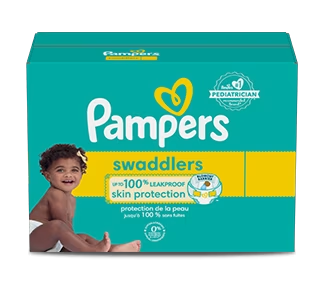Baby Pee and Wet Diapers: Urinary Frequency, Colour, and Smell
Ever wondered about baby pee beyond just changing diapers? Parents often ask how many wet diapers a newborn should have and what the different smells and colours might mean. Our guide to baby pee answers all these questions and more! By the end, you’ll have a clearer picture of how many wet diapers you should expect from your newborn and when to contact your child’s healthcare provider.
How Many Wet Diapers Should a Newborn Have?
In the first day, expect your newborn to have just one wet diaper. As your little one starts drinking more milk, the number of wet diapers will increase. By the end of the first week, you may notice about four to six wet diapers daily.
You can learn more about how many newborn diapers you'll need in our dedicated guide.
What Does It Mean if Your Baby Is Peeing a Lot?
If it seems that your baby is peeing a lot, that’s usually a good thing and typically means they’re getting enough to eat. In your baby’s first month, if you're breastfeeding and your milk supply is well established, six or more wet diapers a day generally indicates that your baby is getting adequate nourishment.
What Does It Mean if Your Newborn Is Not Peeing?
If you notice your newborn is not peeing very often (fewer than four times a day), your baby could be ill, have a fever, or be managing the heat. With illnesses, fevers, or hot weather, your baby’s output of urine may drop by half. It's best to contact your baby's healthcare provider, as this is likely a sign of dehydration.
As your baby recovers and the weather becomes cooler, you'll likely notice their usual peeing habits returning.
If you have concerns about your baby's lack of pee or you think they're not getting enough milk, contact their healthcare provider for guidance.
Related diapering tool
Diaper Size Calculator
Find out your baby's diaper size, how many diapers you'll need per day and for how long:
Newborn Pee Colour
Baby pee looks similar to adult pee, in that the urine of healthy newborns has a light to dark yellow pee colour. Darker shades indicate concentrated urine, which may mean that your baby is slightly dehydrated. But in general, a normal pee colour for a newborn is a shade of yellow.
Light to Dark Yellow Baby Pee
As mentioned above, light yellow urine is healthy. It means your baby is getting enough nourishment and peeing regularly. The darker the yellow colour, the more concentrated the urine. Although a healthy baby can have dark-yellow urine, this colour could also indicate that your little one needs to consume more liquids to stay hydrated.
Pink, Orange, Red, or Brown Baby Pee
A pink, orange, red, or brown hue to your baby’s pee can mean a few different things. Some conditions are temporary, some are harmless, and some need medical attention.
Pink. A pink spot on the diaper might look like blood, but it's usually just concentrated urine. If your baby is peeing frequently, there's likely no need to worry. But if the colour stays, check with your child's doctor. In newborn girls, a pink stain might be temporary due to mom's hormones. If pink spots or pee persist after 1 week, consult their healthcare provider.
Orange, red, or brown. An orange, red, or brown tint may indicate the presence of blood in your newborn’s urine. Whether you have a baby boy or girl, blood in pee (after 1 week for girls) is not normal and usually means there’s a problem. The medical name for this condition is hematuria, and it can be caused by many things, including physical injury, inflammation, infection, kidney stones, etc.
If you suspect blood in your newborn’s urine and see a pink, orange, red, or brown tint, contact your child’s healthcare provider ASAP. If it’s hematuria, the provider can address it quickly.
After your baby starts eating solid foods, any unusual colors in their pee might just be from foods like beets or blackberries. To ease your worries, it's best to check in with a healthcare provider who can pinpoint the cause and ensure your baby gets the right care if needed.
Red or Brown and Cloudy Baby Pee
If your baby’s pee is cloudy and accompanies a colour change, it could be a urinary tract or kidney infection. A kidney infection is actually a type of UTI, so these can go hand-in-hand. Contact your child’s healthcare provider ASAP if you notice any cloudy urine, especially if it also has a red or brown hue. This could be among the symptoms of urine infection in infants.
“Brick Dust” Baby Pee
A common descriptor of a red-brown hue in baby pee is “brick dust. ” It actually looks a bit like dust from red bricks sprinkled into the urine, often mistaken for blood. When you see this in your baby’s pee, it could mean they’re not nursing enough or consuming enough formula. This “dust” is actually urate crystals, which will not appear once your baby consumes more fluids and nutrients.
Baby Urine Colour Chart
Much like our poop chart for newborns, we’ve created one for pee, so you’ll have an easy guide as to what your baby’s urine may be telling you. Our pee and poop charts for newborns are a handy reference for parents.
| Shades of Baby Pee—A Rough Guide | |
|---|---|
| Colour/Consistency | What It Might Mean |
| Light Yellow | Healthy and nothing to worry about |
| Dark Yellow | Usually healthy but might indicate dehydration |
| Pink | Highly concentrated urine |
| Red | Blood in urine or due to food or medication |
| Orange | Blood in urine or due to food or medication |
| Brown | Blood in urine or due to food or medication |
| Cloudy (Milky/White) | A kidney or urinary tract infection |
| “Brick Dust” | Inadequate fluids |
Baby Pee Smells
Along with concerns about your newborn’s pee colour, you may also wonder what it means when your baby’s urine is especially smelly. Sometimes, colourful pee and smelly pee indicate the same thing.
Strong Smelling Urine in Babies
In some cases, strong, foul-smelling pee may indicate symptoms of urine infections in infants, such as a bacterial infection like a urinary tract infection (UTI), which can cause serious illness if left untreated. When a baby’s urine smells particularly strong, kind of like ammonia, look for signs of an infection, which include blood in urine, plus cloudy and smelly pee. Babies with a UTI may also have a fever, start peeing a lot more frequently, or show signs of discomfort while urinating.
However, a strong pee smell doesn’t always indicate an infection. If your breastfed baby’s urine smells strong and is highly concentrated with a dark yellow colour, your little one may be dehydrated. Giving your baby more fluids (just breast milk or formula until 6 months old) will typically do the trick.
Diet and medication can also be reasons that your baby's pee smells strong. Check in with your little one’s healthcare provider with any concerns about this.
Sweet-Smelling Pee
This may sound a little odd, but your baby’s pee might smell sweet like maple syrup. This odour indicates a rare, serious illness called Maple Syrup Urine Disease (MSUD), which typically shows signs either within the first three days of birth or between 5 months and 7 years. It’s a metabolic disorder that stops the body from properly converting food to energy.
Diabetes is another disease that could cause sweet-smelling baby pee. Because both diabetes and MSUD are very serious conditions, contact your child’s healthcare provider if you notice a sweet smell to your baby’s pee.
FAQs at a Glance
Healthy baby pee is yellow, whether light or dark or somewhere in between. The darker the shade of yellow, the more concentrated the urine. You want your baby to be well-hydrated, so if they have dark yellow pee, they may need to consume more liquids.
Babies younger than 6 months should consume only breast milk or formula. At 6 months, you can start introducing water to your baby little by little.
The Bottom Line
As you’ve discovered, baby pee can sometimes be more complicated than just changing a diaper! Still, those daily diaper changes offer opportunities to monitor your baby’s health. Pay attention to the number of wet diapers, the colour of your baby’s pee, and even the smell of your baby’s pee. All of these can reassure you that your little one is thriving or suggest that you’ll need to contact your child’s healthcare provider.To sum it up:
Urinary frequency. Most newborns should have at least four to six wet diapers a day, although how many your baby produces could end up being one every hour or every three hours.
Urine colour. A healthy baby has yellow pee—either light, dark, or somewhere in between. Pink-tinted pee usually means highly concentrated urine, whereas red, orange, or brown hues indicate blood, which isn’t normal.
Urine smell. Baby pee can smell strong without any issues. But if your baby’s pee smells particularly strong or foul, it could be a sign of a UTI.
Now that you understand the ins and outs of baby pee, you’ll have a better idea of how many wet diapers for your newborn will come your way and when their urine (or lack of it) indicates a problem. In the meantime, download the Pampers Club App and reward yourself for all those diaper changes with Pampers Cash!
How We Wrote This Article The information in this article is based on the expert advice found in trusted medical and government sources, such as the American Academy of Pediatrics and the American College of Obstetricians and Gynecologists. You can find a full list of sources used for this article below. The content on this page should not replace professional medical advice. Always consult medical professionals for full diagnosis and treatment.
Join Pampers Club and get:





